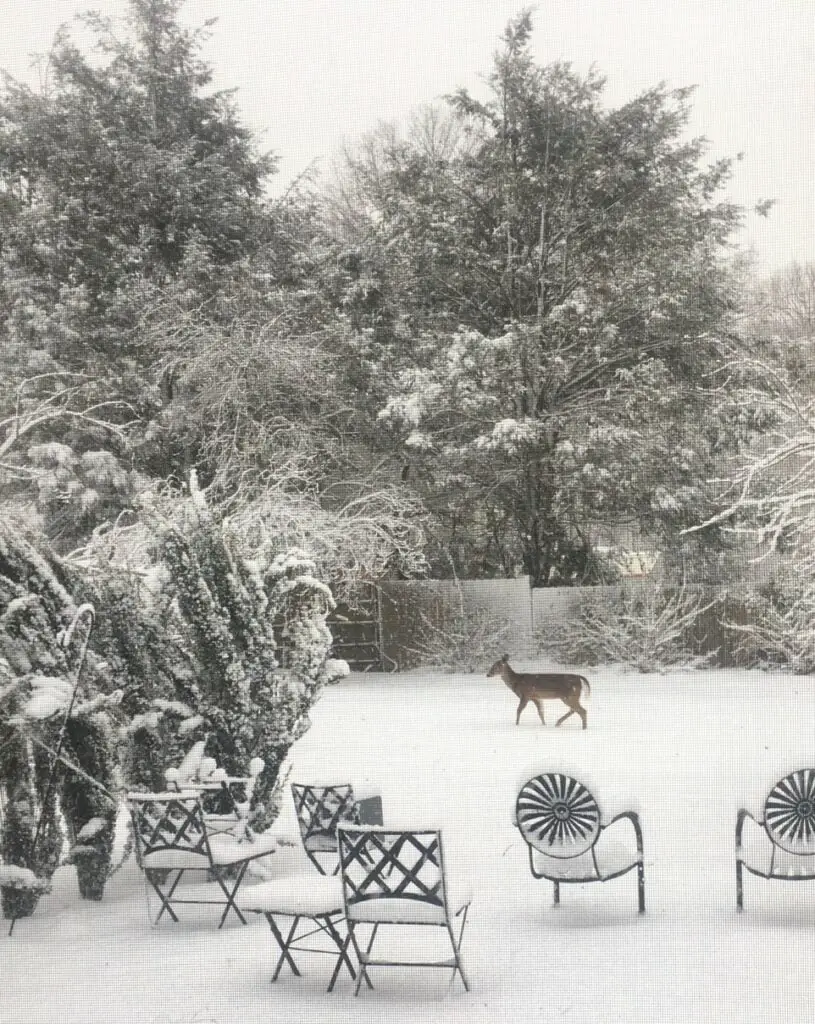Weight Of Sand Vs Water
Weight of Snow • Comprehensive Reference Chart
By Roof Online Staff • Concluding updated September 23, 2022
See More than Covering Topics
Table of Contents
- Introduction
- What Determines Snow Density?
- Why You Should Know How Heavy Snow Is
- Most Our Snow Weight Table
- Table: Weight of Snowfall for Diverse Snowfall Types
- Related Pages
- Snow Weight References

Introduction
The weight of snow is a vital piece of data. Whole sections of the building code are based on knowing how much additional weight a structure will need to back up due to the typical snow loads in a given region.
There is no foolproof dominion of thumb regarding snowfall weight. To estimate snow weight accurately, you need to know the conditions nether which the snow formed, and what weather the snow has experienced since it savage.
Snow can vary in weight from a little over a pound to as much every bit thirty pounds per cubic pes. Fresh, dry, fluffy snow might only weigh virtually 4 pounds per cubic human foot. Snow that has been sitting for a few days under normal conditions will unremarkably weigh effectually 15 pounds per cubic foot.
But there are variables, and they brand a large difference.
What Determines Snow Density?
Snow density is a part of temperature, wind exposure, and fourth dimension.
Snow density increases over time every bit the snow experiences more than changes in temperature and wind. Warmer temperatures lead to higher (and heavier) wet content; the water may re-freeze into ice when the temperature drops.
Wind abrades snowfall particles, making them smaller and so they fit together more tightly, compacting the snowfall, and then snowfall volition be heavier after windy weather.

Why You Should Know How Heavy Snowfall Is
The weight of snow can be an important piece of information for a number of reasons.
For instance, a typical scoop of snowfall with a snow shovel is well-nigh one.5 cubic anxiety, so there's a practiced adventure you're out there lifting more than 30 lbs. over and over once again while yous're clearing your driveway. It's good to know the weight of snow.
Roof collapsedue to the weight of snow exceeding the load-bearing capacity of a roof structure is a primary business of people looking up the weight of snow. For in-depth information on how the weight of snowfall may affect your roof, delight see the links available on our page Snowfall Issues and Roofs.
If you're because trying to remove snow from your roof yourself, please come across these snow rakes (on Amazon). They are designed to allow snow to exist removed while you are continuing on the basis. Using a ladder in the snow can be extremely dangerous.
Most Our Snowfall Weight Tabular array
The post-obit tabular array provides the typical weight of snow (or snow density) for snow that has formed and accumulated under various conditions.
Weights for air, ice, and liquid water are as well included, as these are the three principal components of snow. The weight of snow is a production of the percentage of each of these things inside a given volume of snow. (We do non business relationship for dirt, droppings, etc. when calculating the weight of snowfall.)
Table: Weight of Snow for Various Snow Types
All weightsgiven in this table are approximations and real earth values will vary.
| Weight of Snow | ||||||
|---|---|---|---|---|---|---|
| Type of Snowfall | Lbs per Inch of Depth per Square Foot (Average) | Lbs per Cubic Human foot (lb/ft³) (Average) | Lbs per Cubic Foot (lb/ft³) (Range) | Grams per Cubic Centimeter (m/cm³) (Range) | Kg per Cubic Meter (kg/m³) (Boilerplate) | Kg per Centimeter of Depth per Square Meter (Boilerplate) |
| Air (Average weight of air at sea level at freezing.) | 0.007 lbs | 0.08 lb/ft ³ | 0.08 lb/ft ³ | 0.0013 g/cm ³ | 1.29 kg/m ³ | 0.0129 kg |
| Wild Snowfall (Light, very dry new snow. Snow immediately afterward falling, in extremely common cold temperatures, with no air current.) | 0.1 lbs | 1.25 lb/ft ³ | 0.62 – 1.87 lb/ft ³ | 0.01 – 0.03 g/cm ³ | 20 kg/m ³ | 0.twenty kg |
| Ordinary New Snowfall (Snowfall immediately after falling, in below-freezing temperatures, with no wind; fresh, uncompacted snow that has a high volume of trapped air.) | 0.three lbs | 3.59 lb/ft ³ | three.12 – 4.06 lb/ft ³ | 0.05 – 0.065 g/cm ³ | 57.5 kg/m ³ | 0.58 kg |
| New Snow Slightly Compacted by Wind (Snowfall immediately after falling, in below-freezing temperatures, with some air current exposure. Less trapped air.) | 0.37 lbs | four.46 lb/ft ³ | iii.93 – 4.99 lb/ft ³ | 0.063 – 0.08 g/cm ³ | 71.v kg/m ³ | 0.715 kg |
| Settling Snow (Snow less than a mean solar day one-time that is starting to feel some wind and temperature variation.) | 0.68 lbs | 8.12 lb/ft ³ | 4.37 – eleven.86 lb/ft ³ | 0.07 – 0.19 g/cm ³ | 130 kg/m ³ | one.30 kg |
| Damp New Snow (Snow immediately after falling, in slightly above-freezing temperatures, with piddling wind exposure.) | 0.78 lbs | 9.37 lb/ft ³ | 6.24 – 12.49 lb/ft ³ | 0.ane – 0.ii g/cm ³ | 150 kg/m ³ | i.50 kg |
| Carbohydrate Snow (Snow with large grains formed when water vapor freezes onto existing snow crystals.) | 1.04 lbs | 12.49 lb/ft ³ | half dozen.24 – 18.73 lb/ft ³ | 0.1 – 0.3 g/cm ³ | 200 kg/grand ³ | 2 kg |
| Settled Snowfall (Typical afterward more one solar day in place. Snow that has experienced some temperature and wind variation.) | 1.3 lbs | fifteen.61 lb/ft ³ | 12.49 – 18.73 lb/ft ³ | 0.2 – 0.3 chiliad/cm ³ | 250 kg/m ³ | 2.5 kg |
| Average Air current-Toughened Snow (Compacted snow after wind exposure in below-freezing temperatures.) | one.46 lbs | 17.48 lb/ft ³ | 17.48 lb/ft ³ | 0.28 g/cm ³ | 280 kg/m ³ | ii.viii kg |
| Wet Snow (Dense, viscous snow in relatively warm temperatures with little wind. Good snow for making snowballs.) | 1.75 lbs | 21 lb/ft ³ | 17 – 25 lb/ft ³ | 0.27 – 0.40 m/cm ³ | 335 kg/m ³ | iii.35 kg |
| Wind-Packed Snow (Hard Current of air Slab. Compacted snow after prolonged and heavy wind exposure.) | ane.98 lbs | 23.73 lb/ft ³ | 21.85 – 25.six lb/ft ³ | 0.35 – 0.41 g/cm ³ | 380 kg/m ³ | 3.viii kg |
| New Firn Snow (Firn is granular, icy, highly-compacted, pre-glacial snow. Some ice present.) | 2.47 lbs | 29.66 lb/ft ³ | 24.97 – 34.34 lb/ft ³ | 0.40 – 0.55 k/cm ³ | 475 kg/m ³ | iv.75 kg |
| Avant-garde Firn Snow | iii.12 lbs | 37.46 lb/ft ³ | 34.34 – 40.58 lb/ft ³ | 0.55 – 0.65 grand/cm ³ | 600 kg/one thousand ³ | 6 kg |
| Thawing Firn Snowfall | 3.38 lbs | 40.58 lb/ft ³ | 37.46 – 43.70 lb/ft ³ | 0.6 – 0.7 k/cm ³ | 650 kg/k ³ | 6.v kg |
| Slush (Advanced melting snow; snow/water mix.) | 3.75 lbs | 45 lb/ft ³ | 35 – 55 lb/ft ³ | 0.56 – 0.88 k/cm ³ | 720 kg/one thousand ³ | 7.two kg |
| Ice with Air Bubbles (Cloudy ice.) | 4.5 lbs | 54 lb/ft ³ | 51.19 – 56.81 lb/ft ³ | 0.82 – 0.91 g/cm ³ | 873 kg/m ³ | 8.73 kg |
| Pure Ice (Water ice with no entrapped air.) | iv.77 lbs | 57.25 lb/ft ³ | 57.25 lb/ft ³ | 0.92 1000/cm ³ | 917 kg/thou ³ | nine.17 kg |
| Water (At sea level merely above freezing.) | 5.ii lbs | 62.43 lb/ft ³ | 62.43 lb/ft ³ | 1 grand/cm ³ | 1000 kg/m ³ | ten kg |
- Building Codes and Roofs
- How to Find the Expanse of a Sloped Roof
- Snow Issues and Roofs
- Weight of Roofing Materials
- Weight of Water per Inch for Ponding Water
Snow Weight References
- 2018 International Building Code, Chapter 16 Structural Design, Section 1608 Snow Loads; International Code Council; 2017
- Snowfall, National Snow and Ice Data Centre
- Handbook of Snow: Principles, Processes, Management & Apply; Gray and Male; 1981
- The International Classification for Seasonal Snow on the Ground; International Association of Cryospheric Sciences; 2009
- Snow Structure and Ski Fields, existence an Account of Snowfall and Ice Forms met with in Nature and a study on Avalanches and Snowcraft; M. Seligman; With an Appendix on Alpine Weather; C. Chiliad. M. Douglas; 1936
Weight Of Sand Vs Water,
Source: https://roofonline.com/weights-measures/weight-of-snow/
Posted by: laportepuldivis.blogspot.com


0 Response to "Weight Of Sand Vs Water"
Post a Comment